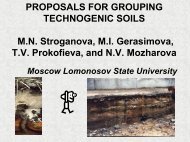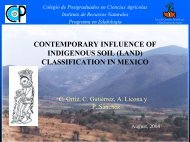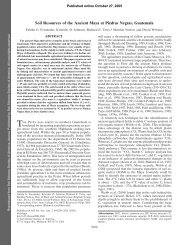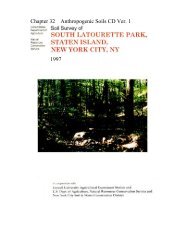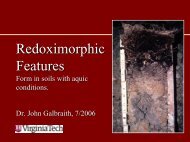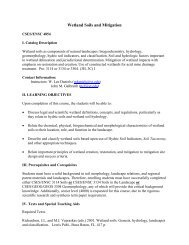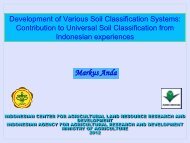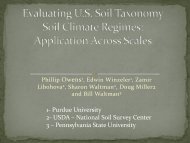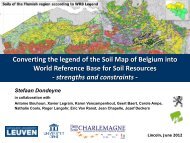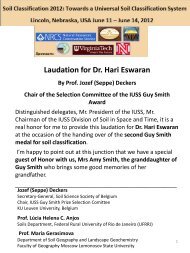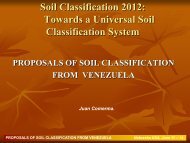Nebraska Soils Field Trip - Virginia Tech
Nebraska Soils Field Trip - Virginia Tech
Nebraska Soils Field Trip - Virginia Tech
You also want an ePaper? Increase the reach of your titles
YUMPU automatically turns print PDFs into web optimized ePapers that Google loves.
4th IUSS Soil Classification Conference <strong>Field</strong> Tour Guidebook<br />
LOCATION AKSARBEN NE +KS<br />
Established Series<br />
SAS, LGR, PTC<br />
06/2008<br />
AKSARBEN SERIES<br />
The Aksarben series consists of very deep, well drained soils formed in loess on uplands. Slope<br />
ranges from 0 to 11 percent. Mean annual air temperature is about 11 degrees C, and mean<br />
annual precipitation is about 74 centimeters.<br />
TAXONOMIC CLASS: Fine, smectitic, mesic Typic Argiudolls<br />
TYPICAL PEDON: Aksarben silty clay loam with a convex slope of 1 percent - cultivated.<br />
(Colors are for moist soil unless otherwise stated.)<br />
Ap--0 to 15 centimeters; very dark grayish brown (10YR 3/2) silty clay loam, dark grayish<br />
brown (10YR 4/2) dry; weak fine granular structure; slightly hard, friable; many very fine and<br />
fine roots throughout; many fine and medium tubular pores; moderately acid; abrupt smooth<br />
boundary.<br />
A--15 to 30 centimeters; very dark grayish brown (10YR 3/2) silty clay loam, dark grayish<br />
brown (10YR 4/2) dry; weak fine subangular blocky structure parting to weak fine granular;<br />
slightly hard, friable; many very fine and fine roots throughout; many fine and medium tubular<br />
pores; moderately acid; clear smooth boundary. (Combined thickness of the A horizons is 15 to<br />
51 centimeters)<br />
Bt1--30 to 46 centimeters; dark brown (10YR 3/3) silty clay loam, brown (10YR 5/3) dry;<br />
moderate medium subangular blocky structure parting to strong fine subangular blocky; hard,<br />
firm; common fine roots throughout; common fine tubular pores; many faint very dark grayish<br />
brown (10YR 3/2) continuous clay films (cutans) on vertical and horizontal faces of peds;<br />
slightly acid; clear smooth boundary.<br />
Bt2--46 to 66 centimeters; brown (10YR 4/3) silty clay loam; brown (10YR 5/3) dry; few fine<br />
distinct dark yellowish brown (10YR 4/6) iron masses in the soil matrix; the iron accumulations<br />
are relict redox features; moderate coarse subangular blocky structure parting to strong fine and<br />
medium subangular blocky; hard, firm; few fine roots throughout; few fine tubular pores; many<br />
faint dark brown (10YR 3/3) continuous clay films (cutans) on vertical and horizontal faces of<br />
peds; few fine irregular soft masses of iron-manganese; slightly acid; gradual smooth boundary.<br />
Bt3--66 to 86 centimeters; brown (10YR 4/3) silty clay loam, pale brown (10YR 6/3) dry;<br />
prominent strong brown (7.5YR 5/6) iron masses in the soil matrix; the iron accumulations are<br />
relict redox features; moderate coarse prismatic structure parting to strong medium subangular<br />
blocky; hard, firm; few very fine roots throughout; few very fine tubular pores; many faint dark<br />
brown (10YR 3/3) continuous clay films (cutans) on vertical and horizontal faces of peds;<br />
common fine irregular soft masses of iron-manganese; slightly acid; gradual smooth boundary.<br />
51



